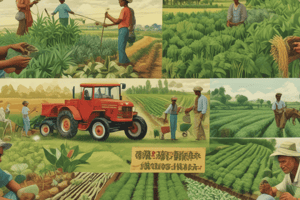Podcast
Questions and Answers
- Explain the significance of MS Swaminathan's contribution to Indian Agriculture.
- Explain the significance of MS Swaminathan's contribution to Indian Agriculture.
MS Swaminathan's contribution to Indian Agriculture is significant as he worked with Norman Borlaug to introduce the Green Revolution in India during the 1960s. This revolution helped transform Indian agriculture and prevented millions of deaths from starvation.
- What was the state of Indian agriculture before the Green Revolution?
- What was the state of Indian agriculture before the Green Revolution?
Before the Green Revolution, Indian agriculture was facing back-to-back droughts and the country was importing 10 million tonnes of food from the US under the P.L.480 scheme. It was termed as a "ship to mouth" economy.
- Discuss the objectives, features, impacts, challenges, and solutions related to the Green Revolution in India.
- Discuss the objectives, features, impacts, challenges, and solutions related to the Green Revolution in India.
The Green Revolution in India aimed to increase agricultural productivity, reduce food scarcity, and improve food security. It involved the introduction of high-yielding varieties of crops, modern farming techniques, and the use of fertilizers and irrigation. The revolution had a significant impact on increasing food production, but it also faced challenges such as environmental degradation and socio-economic inequality. Green Revolution 2.0 focuses on sustainable and inclusive agriculture.
- What are genetically modified (GM) crops and their relevance to the Green Revolution?
- What are genetically modified (GM) crops and their relevance to the Green Revolution?
- How do millets relate to the Green Revolution and its future prospects?
- How do millets relate to the Green Revolution and its future prospects?
Study Notes
M.S. Swaminathan's Contributions to Indian Agriculture
- Father of the Green Revolution in India: Known for his pivotal role in transforming Indian agriculture through scientific innovation and research.
- Introduction of High-Yielding Varieties (HYVs): Introduced new varieties of wheat and rice that significantly boosted crop yields.
- Establishment of the Indian Council of Agricultural Research (ICAR): A leading institution for agricultural research and development, fostering innovation and expertise.
- Championing Sustainable Agricultural Practices: Emphasized the importance of integrated pest management, crop rotation, and soil conservation.
Indian Agriculture Before the Green Revolution
- Low Productivity: Characterized by low yields and dependence on traditional farming techniques.
- Food Scarcity: Frequent food shortages and reliance on imports to meet domestic demand.
- Limited Infrastructure: Inadequate irrigation facilities, storage, and transportation systems hampered agricultural development.
- Poverty and Malnutrition: High levels of poverty and malnutrition due to inadequate food production.
Green Revolution in India
Objectives
- Increased Food Production: To achieve self-sufficiency in food production and meet the growing needs of a rapidly expanding population.
- Improved Rural Livelihoods: To enhance the income and living standards of farmers and rural communities.
- Economic Growth: To contribute to overall economic growth through increased agricultural productivity.
Features
- High-Yielding Varieties (HYVs): Introduction of new varieties of crops with higher yields and shorter maturity periods.
- Increased Fertilizer Use: Extensive use of chemical fertilizers and pesticides to enhance crop growth and minimize pest damage.
- Improved Irrigation: Development of irrigation systems to expand the area under cultivation and ensure water supply.
- Modern Agricultural Practices: Adoption of scientific practices, such as crop rotation, intercropping, and integrated pest management.
Impacts
- Increased Food Production: Achieved self-sufficiency in food production, significantly reducing reliance on imports.
- Improved Rural Livelihoods: Enhanced incomes for farmers and contributed to the overall economic growth of rural areas.
- Reduced Poverty and Malnutrition: Contributed to reducing poverty and malnutrition levels in India.
Challenges
- Environmental Degradation: Intensive use of fertilizers and pesticides led to soil degradation, water pollution, and biodiversity loss.
- Dependence on External Inputs: Increased reliance on chemical fertilizers, pesticides, and irrigation created a dependence on external inputs.
- Economic Inequality: Benefits of the Green Revolution were unevenly distributed, with large farmers benefiting more than smallholders.
- Social Impacts: Displacement of small and marginal farmers due to the adoption of mechanized agriculture.
Solutions
- Sustainable Agricultural Practices: Promoting organic farming, integrated pest management, and water conservation to minimize environmental damage.
- Diversification of Crops: Encouraging the cultivation of a wider range of crops, including millets and pulses, to enhance food security and nutritional diversity.
- Support for Small Farmers: Implementing policies and programs to support small and marginal farmers, including access to technology, credit, and markets.
- Investing in Rural Infrastructure: Focusing on improving rural infrastructure, such as irrigation, storage, and transportation systems, to strengthen the agricultural sector.
Genetically Modified (GM) Crops
- Genetically Modified (GM) Crops: Crops whose genetic makeup has been altered through biotechnology to enhance desirable traits, such as resistance to pests, diseases, or herbicides.
- Relevance to Green Revolution: Offer potential to further increase crop yields, reduce reliance on chemical inputs, and improve food security.
- Controversy: Concerns about potential environmental and health risks associated with GM crops, leading to debates on their safety and long-term impacts.
Millets in the Green Revolution and its Future Prospects
- Millets: Indigenous grains that are drought-tolerant, require less water, and have high nutritional value.
- Relevance to Green Revolution: Potential to increase food security in areas with limited water resources and contribute to climate-resilient agriculture.
- Future Prospects: Growing interest in promoting millets as a sustainable and nutritious food source, potentially contributing to the "Second Green Revolution."
Studying That Suits You
Use AI to generate personalized quizzes and flashcards to suit your learning preferences.
Description
Test your knowledge on the Green Revolution in India and the contributions of MS Swaminathan with this quiz. Explore topics such as the P.L.480 scheme, Green Revolution





